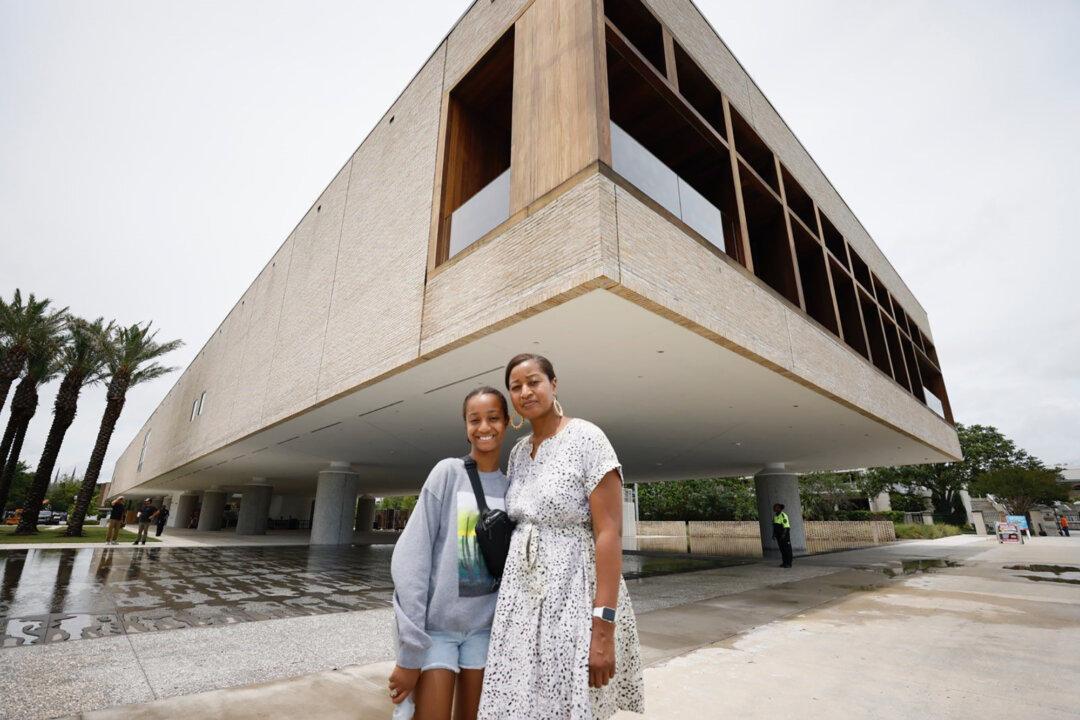Charleston—The first time I viewed the Charleston Harbor, I was standing at the former site of Gadsden’s Wharf, where more than 40% of the nation’s enslaved Africans had arrived centuries ago when they were forced into chattel slavery.
I stood with my 12-year-old daughter facing the water at precisely the point where thousands of captured Africans likely began their journey in America. Like many Black Americans, I can trace at least one of my ancestors to the area, and I believed that my great, great grandmother could somehow feel our presence.
This, I imagine, is what many other Black people will feel when they visit the International African American Museum (IAAM), which opened in June in Charleston. “When any visitor comes, and particularly when visitors of African descent visit, there’s a kind of reclamation,” said Malika N. Pryor, chief learning and engagement officer of IAAM, who gave us a tour of the museum during our weeklong trek across three states to visit five Black history museums in the South.
The museum, a stunningly beautiful and long-awaited testament to the depth of African American history and culture in South Carolina and beyond, is the first major Black history museum to open in several years. It sits high above the ground, not just for aesthetic value but also because the architect, the late Henry Cobb, determined that the building must never touch the sacred ground on which it stands.
The story, thus, begins on the ground, in the African Ancestors Memorial Garden, a series of outdoor spaces embodying different aspects of the African experience designed by landscape architect Walter Hood.
The edge of Gadsden’s Wharf notes the many points of departure from Africa and the many points of arrival of enslaved Africans in the Americas as water ebbs and flows over shadowy silhouettes representing bodies in the hold of slave ships. Just past a grove of palm trees, five figures kneeling between two granite walls, what Hood called “the gauntlet”, serves as a memorial in the place where enslaved people were warehoused before being sold. But when viewed from the outside, we only see the hopeful words of Maya Angelou’s “And Still, I Rise.”
“We have this intersection between what that brick outlay represents and what the gauntlet represents and there lies the intersection that we endeavor to engage at every single stage in the museum experience,” said Pryor. “The promise, the victory, the triumph, the joy, but also, great trauma.”
Inside the museum, a multi-sensory experience begins with eight-foot screens that feature stills and video, a trailer for all that is to come in the museum’s nine galleries. I found myself moving through the museum looking rapidly from one side to the next, trying to appreciate all the things I knew and absorb all the things I did not know.
The Gullah Geechee offers insight into the culture that spans hundreds of years and four states, including Georgia, and which holds an undeniable place in South Carolina’s cultural landscape, though it is exceptional precisely because of its deep connection to West African identity.
In Memories of the Enslaved, quotes from formerly enslaved people and insight from their descendants gives testimony to their experiences. The facing gallery, Carolina Gold, tells us exactly how Charleston became a stronghold of U.S. wealth when planters set out to strategically capture Africans from rice-cultivating cultures and utilize both their free labor and free knowledge.
A walk through American Journeys begins in South Carolina’s early days as a new colony and moves through more than 600 years of the Black experience between two halls. The focus is aimed at South Carolina, yet deftly moves from narrow to broad, ensuring that the exhibit speaks to the collective African American history.
A bonus of IAAM, and something I have not seen at a museum, is the Center for Family History, which currently offers records searches at kiosks through a partnership with Family Search. Over time, museum staff plan to expand the database to include significant records from South Carolina’s long history that will help African Americans get past the brick wall of 1870, the year when African Americans appeared with surnames for the first time in census records.
IAAM is the kind of museum I wish I had when I was younger. It is the kind of museum I hope will serve younger generations who might find themselves curious about parts of American history they may or may not learn in school.
I wondered, why did it take so long for an institution like this to arrive in a city like Charleston?
That’s a question I’ll explore more deeply in an upcoming series of stories about my journey with my daughter to Black history museums in the South.
IAAM’s CEO, Tonya Matthews, said it took time to build support and nail the approach.
“We’re stewarding stories that have long been held by the community itself. We’ve got to make sure we’re telling them right,” said Matthews during our interview last week. “As times change, so do people. What people want to hear, what they want to talk about, the way the stories need to be told also changes and all of that came together to bring us to the moment we are in today.”
Copyright 2023 The Atlanta Journal-Constitution. Visit at ajc.com. Distributed by Tribune Content Agency, LLC.
Dear Readers: We would love to hear from you. What topics would you like to read about? Please send your feedback and tips to [email protected].





